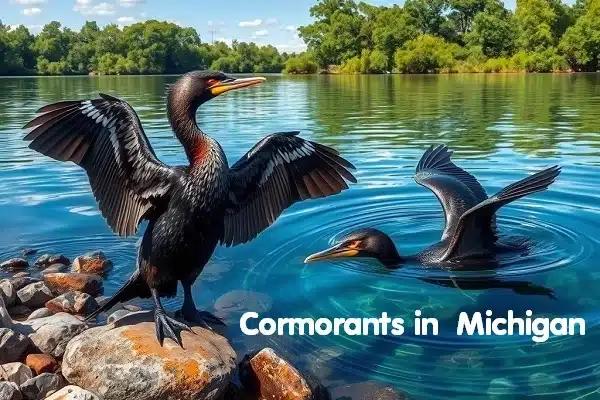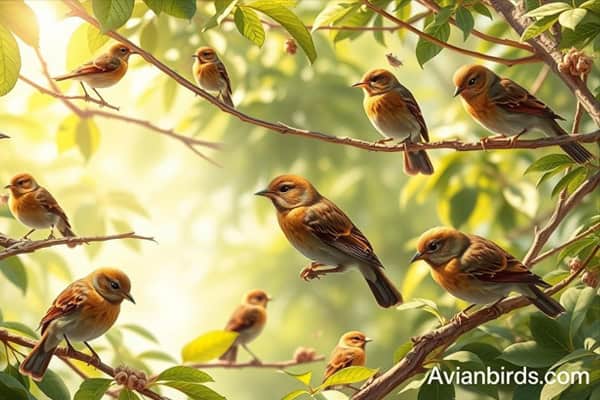10 Types of Black Birds With White Bellies (ID Guide)
Did you know North America is home to over 900 Black birds with White Bellies? Among them, some stand out with their black feathers and white bellies. This guide will take you on a journey to learn about ten amazing black birds with white bellies. It’s perfect for improving your bird identification skills.
These birds are not just beautiful; they also play important roles in nature. They help control pests and spread seeds. Whether you’re an expert or new to birdwatching, spotting these birds can make your outdoor time more exciting. Let’s start exploring these unique black birds with white bellies!
Introduction to Black Birds With White Bellies
Black birds with white bellies catch our eye with their unique look and interesting ways. They add fun to birdwatching by bringing a new twist. These birds, with their black and white colors, are a favorite among bird lovers for their beauty and how they move through the air.
These birds have striking black tops and white bottoms, making them stand out. This look is not just for show; it helps them survive. When we go birdwatching, we see how their colors help them hide and communicate, making it more interesting.
- Observe their flight patterns for better identification.
- Take note of their habitats to understand their behavior.
- Listen to their calls, as many species have distinctive sounds.
Using these tips makes birdwatching more fun and meaningful. Whether you’re new to it or have been doing it for years, learning about black birds with white bellies makes your time outdoors more exciting.
1. Black-billed Magpie
- Scientific Name: Pica hudsonia
- Size: 40–50 cm (15.7–19.7 in)
- Weight: 150–250 g (5.3–8.8 oz)
- Lifespan: 4–10 years
- Diet: Insects, seeds, fruits, and carrion.
The Black-billed Magpie catches our eye with its bold look and striking colors. It stands out with its black and white feathers. This bird is easy to spot because of its unique traits.

Physical Characteristics
These birds have mainly black bodies with white patches on their wings and belly. Their long tail shines blue-green in the light. This makes them a favorite among bird lovers.
Habitat and Distribution
Black-billed Magpies live in open places like meadows and near water. They are found from the central US to Alaska. Cities also provide a good home for them, making them easy to see.
Diet and Feeding Habits
Black-billed Magpies eat a mix of fruits, grains, insects, and even dead animals. They can eat many types of food, which helps them live in different places.
| Feature | Details |
|---|---|
| Coloration | Black body with white patches on wings and belly |
| Tail Length | Long with blue-green sheen |
| Habitat | Open areas, meadows, grasslands, urban settings |
| Distribution | Western North America (central US to Alaska) |
| Diet | Fruits, grains, insects, small mammals, carrion |
| Feeding Habits | Omnivorous, adaptable to various food sources |
2. Black Skimmer
- Scientific Name: Rynchops niger
- Size: 38–45 cm (15–18 in)
- Weight: 200–400 g (7.1–14.1 oz)
- Lifespan: 10–15 years
- Diet: Fish and invertebrates, skimmed from the water surface.
The Black Skimmer is a standout among coastal birds. It has striking black upperparts and white underparts. Its long, specialized bill is perfect for its unique feeding behavior. This bird skims along the water’s surface to find food, making it a favorite among birdwatchers.
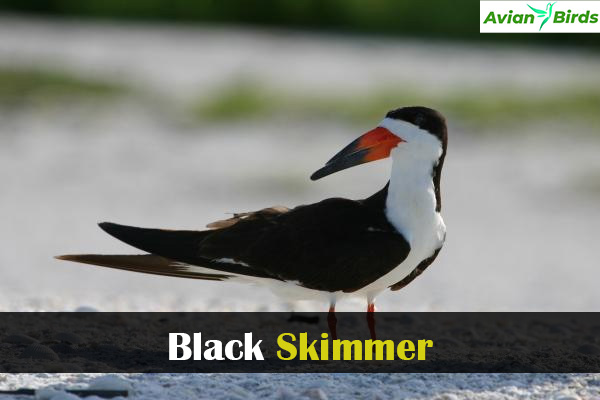
Unique Features
Black Skimmers are both functional and attractive. They have a streamlined shape for flight and webbed feet for swimming. Their contrasting colors make them easy to spot, especially in noisy colonies during breeding season.
Breeding Habitats and Behavior
Black Skimmers live in sandy beaches, estuaries, and salt marshes. In warmer months, they breed in loose colonies on the ground. This protects their eggs from predators and gives them easy access to food.
Learning about the Black Skimmer’s looks and where it lives helps us appreciate these birds more. Their feeding and breeding habits show how well they adapt to coastal life.
3. Black Phoebe
- Scientific Name: Sayornis nigricans
- Size: 15–18 cm (5.9–7.1 in)
- Weight: 15–25 g (0.53–0.88 oz)
- Lifespan: 3–5 years
- Diet: Insects, caught in flight or from surfaces.
The Black Phoebe is a bird that catches the eye with its unique look and different looks in various places. It likes to sit near water, waiting for insects to come close. There’s a special difference in how these birds look, depending on where they live.
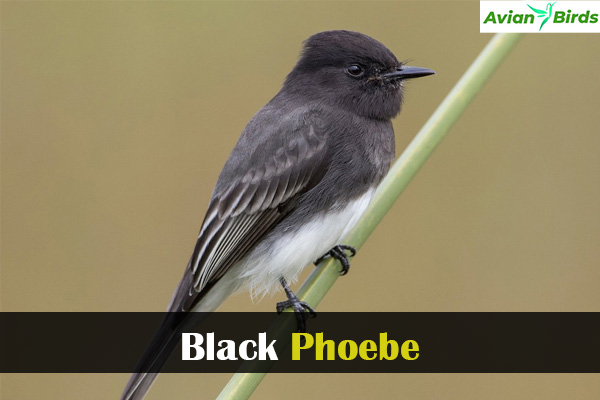
Geographic Variation in Appearance
Looking at the Black Phoebe, we see big differences in how they look in North America versus the south. In North America, they have a less bright look, with duller colors. This shows how their environment shapes their looks.
| Region | Plumage Color | Notable Features |
|---|---|---|
| North America | Duller Black and White | Sleeker body structure |
| South America | Brighter Black and White | More pronounced color contrast |
These changes in how the Black Phoebe looks show how it can adapt to different places. It’s amazing how one bird can change its look based on where it lives and what it finds there.
4. Black-necked Stilt
- Scientific Name: Himantopus mexicanus
- Size: 33–36 cm (13–14 in)
- Weight: 150–300 g (5.3–10.6 oz)
- Lifespan: 3–5 years
- Diet: Insects, crustaceans, and small fish, foraged in shallow water.
The Black-necked Stilt is a standout in the shorebird world. It’s known for its sleek black and white look and long legs. These birds often visit our wetlands, making them a sight to behold.

Learning about their likes and behaviors helps us value their role in nature.
Habitat Preferences
The Black-necked Stilt lives in many places, like shallow ponds, lagoons, and mudflats. They like areas that are good for finding food and making nests. They can live in both natural and man-made wetlands, showing how adaptable they are.
Feeding Strategies
These birds eat mostly aquatic creatures like insects and crustaceans. Watching them feed shows how they use their long legs to search for food in shallow water. This way, they find food efficiently, proving their cleverness in surviving.
| Aspect | Details |
|---|---|
| Habitat Types | Shallow ponds, lagoons, mudflats |
| Feeding Time | Daytime, during low tide |
| Main Diet | Aquatic invertebrates, insects, crustaceans |
| Feeding Behavior | Wading and probing in shallow water |
5. Razorbill
- Scientific Name: Alca torda
- Size: 38–43 cm (15–17 in)
- Weight: 500–800 g (1.1–1.8 lb)
- Lifespan: 13–20 years
- Diet: Fish, particularly herring and sand eels, caught by diving.
The Razorbill is a standout among North Atlantic seabirds. Its bold look during breeding season is a mix of nature’s design and features that help us spot it. This makes it a unique bird to recognize.
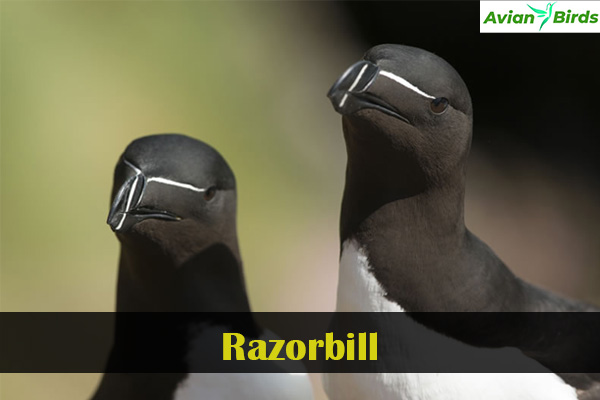
Breeding Plumage Description
When breeding, the Razorbill shows off its special feathers. Its black head and back stand out against the white belly, making it easy to see against the rocky coast. The strong beak with white marks helps identify it too. These looks are not just for show; they play big roles in finding a mate and defending territory.
Distribution in North Atlantic
Razorbills live mainly in the North Atlantic Ocean, choosing rocky coasts and islands for breeding. After breeding, they move south or out to sea. This change helps them survive in different seasons. Their ability to adapt is key to their success.
| Attribute | Description |
|---|---|
| Breeding Plumage | Black head and back with a white belly |
| Beak Features | Robust with white markings |
| Habitat | Rocky coasts and islands |
| Primary Distribution | North Atlantic Ocean |
| Post-breeding Movement | Disperses southward or offshore |
Other Notable Black Birds With White Bellies
Let’s look at more black birds with white bellies. Each one has its own special traits and lives in different places. They make our world more interesting with their looks and actions.
6. Yellow-billed Magpie
- Scientific Name: Pica nutalli
- Size: 40–50 cm (15.7–19.7 in)
- Weight: 150–200 g (5.3–7.1 oz)
- Lifespan: 4–6 years
- Diet: Insects, seeds, fruits, and carrion.
The Yellow-billed Magpie is easy to spot with its bright yellow bill and shiny blue-green wings. It’s found only in California, living in open places like oak woods and farms. They eat a lot of different things, from grains to bugs and even dead animals.

7. Spotted Towhee
- Scientific Name: Pipilo maculatus
- Size: 18–23 cm (7.1–9.1 in)
- Weight: 30–50 g (1.1–1.8 oz)
- Lifespan: 3–5 years
- Diet: Seeds, fruits, and insects, often foraged on the ground.
The Spotted Towhee has a black top and white belly, with white spots on its wings. They live in shrublands and forest edges in western North America. They build their nests in thick plants, fitting right into their home.

8. Atlantic Puffin
- Scientific Name: Fratercula arctica
- Size: 28–30 cm (11–12 in)
- Weight: 500–700 g (1.1–1.5 lb)
- Lifespan: 20–25 years
- Diet: Fish, especially sand eels, caught by diving.
The Atlantic Puffin has a special bill that changes color in the breeding season. These seabirds live on the rocky coasts of the North Atlantic. Their black and white look helps them hide from predators while they hunt for fish.
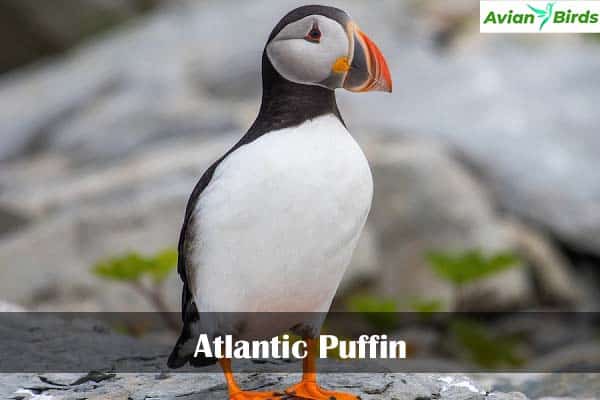
9. Eastern Towhee
- Scientific Name: Pipilo erythrophthalmus
- Size: 18–23 cm (7.1–9.1 in)
- Weight: 30–50 g (1.1–1.8 oz)
- Lifespan: 3–7 years
- Diet: Seeds, fruits, and insects, often foraged on the ground.
To spot an Eastern Towhee, look for its black top and white belly. They like living in shrubs and woodland edges in the eastern U.S. They forage by scratching the ground for seeds and bugs, making them fun to watch.

Conservation Status of Black Birds With White Bellies
Many black birds with white bellies face big challenges due to habitat loss. This is mainly because of urbanization and environmental harm. Their homes are breaking into smaller pieces, making their survival hard. This situation is worrying for bird conservation groups who want to protect these birds and help them live well in nature.
Climate change is also affecting these birds. Changes in weather and food availability mess with their homes and food search. To help, we need to work on restoring their habitats. This means making wetlands, grasslands, and other natural places safe for them.
It’s important to tell people about these birds and their role in nature. By spreading the word, we can get more people to help protect their homes. Together, we can make a big difference in keeping these birds safe and their important jobs in nature.
| Black Bird Species | Conservation Status | Habitat Threats | Conservation Actions |
|---|---|---|---|
| Black-billed Magpie | Least Concern | Urbanization, agriculture | Habitat protection |
| Black Skimmer | Near Threatened | Coastal development | Beach habitat restoration |
| Razorbill | Vulnerable | Climate change effects | Breeding site protection |
| Atlantic Puffin | Least Concern | Overfishing, climate change | Monitoring and research |
By working together and staying committed, we can help these black birds thrive. We can make sure they are around for many years to come.
Read More🐦Related Articles:
| Small Birds with Red Heads |
| Birds Similar to Peacocks |
| Small Birds with Long Legs |
| Red Birds in Florida |
| Small Birds With Long Necks |
Conclusion
We’ve looked into black birds with white bellies and found many interesting species. They are not just beautiful but also important in their ecosystems. Birds like the black-billed magpie and the black skimmer show us how fun birdwatching can be.
As we finish this guide, let’s remember how important these birds are. Learning about their lives helps us enjoy watching them and supports efforts to protect their homes. We must keep working to make sure these birds are around for others to see in the future.
Appreciating black birds more can make our thoughts on this topic richer. To watch birds, try going to their homes at dawn or dusk and watch them quietly. This way, we learn more and feel closer to nature and its many creatures.


